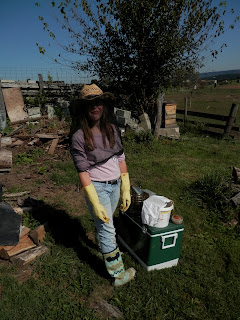I'm more of a "hands off" type of beekeeper. Mostly because I believe it's best for the bees, but also because I just can't find the time to be messing with them frequently.
Earlier this summer we'd taken two and a half gallons of honey from a hive - it's great stuff! - and now it was time to check their honey production again.
We have three hives. The two larger we bought as packages last year and the smaller one we captured as a swarm this spring. (Yes, that was another adventure. We lived.)
Today we wanted to check in on all three hives to see if there was any more honey to take and put another super on the smallest hive. First we gathered our supplies:
The empty super (the wooden box to the left of the photos), veils, gloves, bee brush, smoker fuel and the hive tool. We use the green cooler to store frames of honey. The airtight cooler keeps bugs and air from the honey until it can be harvested.
We had already stripped the honey from the frames and now I wanted to put those empty frames on the smaller hive so they could clean up the foundation, eat the leftover honey and use the additional frames to store more food for the winter.
I loaded the frames into the super while DD lite the smoker and turned to pet our dog, Jack.
Veil, long sleeve shirt, tall boots, pants and a tucked-in shirt are essential if you don't have a full bee jacket or suit. (DD had pushed up her sleeves cause it was hot but was careful to put them down before getting into the hives.) If/when the bees fall off the frames onto the ground, their first instinct is to start climbing anything they can find. Usually that means up the beekeeper's boots and legs. Last summer DD made the mistake of wearing her shirt un-tucked and was stung on the belly.
The beehives are actually quite close to the barnyard but most of our visitors don't even realize they are there unless we point them out. The hives are oriented to the South and are shielded from the hot, late afternoon sun by a tree in the summer. A cement block wall protects them from cold North winds during the winter.
It's proved to be an ideal location.
A concern for beekeepers is providing enough water for their bees. Water is an essential ingredient in honey and the bees need a constant, quiet source to collect what they need. Initially I thought our bees would frequent the pond but we've found they prefer the cement stock tank at the bottom of the pasture.
Most summer days there will be many workers along the water's edge.
All three hives looked good. We'll check them more thoroughly before winter but this day we only quickly opened each hive, took a look at their honey production and added the additional super to the shortest hive. The only area of concern I noticed was a frenzy of activity in front of the small hive after we'd placed the honey super on the hive.
The bees may be difficult to see in the above photo but the noise and activity level in front of this hive made me wonder if they weren't getting robbed of their new honey. I wasn't sure - I don't know if I've ever seen a robber situation - but I went ahead and put an entrance reducer on the doorway of the hive. The entrance reducer just cuts down on access to the hive so the guard bees have a fighting chance of defending their home and honey. We don't want this small hive to be left with no winter stores, we're looking forward to even more honey next summer!









No comments:
Post a Comment